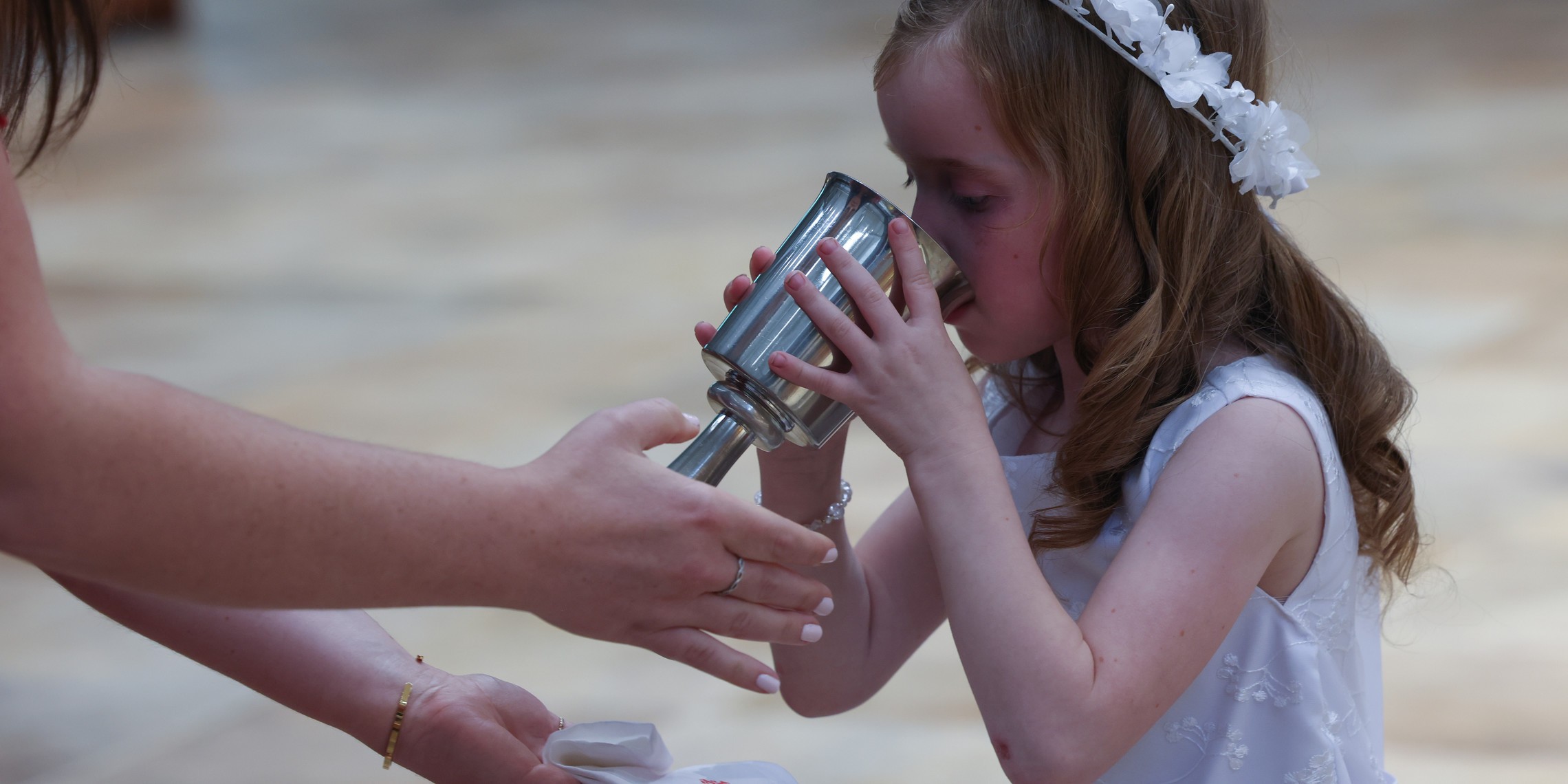April 3, 2023
Holy Week
Hints of spring have sprung. Daffodils and hyacinths adorn our gardens while lawn mowers hum in the background. Lent officially comes to an end on Holy Thursday and perhaps that means we can indulge our sweet tooth or quench our thirst with an ice-cold beer again. This weekend, we find ourselves at the start of Holy Week, the week the Church has been waiting for, fasting for, and praying for. Looking at this incredible week with eyes as fresh as the green grass and leaves sprouting everywhere, can help us to appreciate why we took on the penance of fasting. Why we increased our prayer time and our almsgiving.
Palm Sunday
On Palm Sunday, Jesus’ entered the city walls of Jerusalem greeted with jubilation. He passes cheering crowds who treat Him as if He were an earthly king or military conqueror. Waving palm branches, the people shouted “Hosanna” and laid their cloaks on the ground to honor Him. We begin Palm Sunday with a procession into the church, carrying blessed palms, welcoming Jesus in our midst. Palm Sunday is also called Passion Sunday because the story of Christ’s Passion is proclaimed. With this first hearing of the Passion, it prepares us to walk with Jesus in the coming days knowing what lies ahead for Him. The Passion is read by three people, the narrator, someone who reads the part of the people and the priest who reads the words of Christ. Familiarity with the Passion narrative can make us gloss over verses like John 19:1 “Then Pilate took Jesus and had Him scourged.” Jesus endured a beating and tearing of His flesh so severe that it shortened a normal crucifixion death from a few days to merely three hours. We’ll hear the Passion again on Good Friday but on Palm Sunday, we make our hearts ready for the terrible suffering Jesus will endure. Read the Passion before Palm Sunday, really read it, and imagine yourself in the place of Christ or Mary to feel what they suffered.
The Chrism Mass
At the Chrism Mass, celebrated on Tuesday of Holy Week in the Archdiocese of Cincinnati, Archbishop Schnurr blesses the Holy Oils that the parishes of the Archdiocese will use for the Sacraments throughout the year. The Archbishop blesses three oils. The Oil of Catechumens is used in Baptism to anoint the one to be baptized on the chest prior to being baptized with water. The Oil of the Infirm (sick) is used to anoint the forehead and hands of the person receiving the Anointing of the Sick. The Holy Chrism is used in Baptism and Confirmation by anointing the forehead and in Holy Orders by anointing the hands of a priest and the head of a bishop. Holy Chrism is scented with balsam perfume. Archbishop Schnurr will breathe on the Holy Chrism in the same way that Jesus breathed on the Apostles in John 20:22 “And when he had said this, he breathed on them and said to them, “Receive the Holy Spirit.” Since the Archbishop cannot be physically present at every Baptism and Confirmation in our Archdiocese, he is symbolically present through the holy oils he blesses and consecrates. At the Chrism Mass, the priests of the Archdiocese renew the promises of their ordination to serve God, the Bishop, and His people.
Spy Wednesday
Spy Wednesday is traditionally thought to be the day that Judas betrayed Jesus to the Sanhedrin for thirty pieces of silver. Thirty pieces of silver was the going rate to purchase a slave. This day Jesus was anointed with expensive oil from an alabaster jar, signifying His impending death. (Mt 26:6-13) What a contrast between being bartered for as a slave and being anointed as royalty. The Ancient Office of Tenebrae is celebrated this day. Tenebrae is a Latin word meaning “shadows” or “darkness.”. The service consists of the Psalms, sacred scripture, chanting the Lamentations of Jeremiah and singing the great Passiontide choral settings. In modern liturgical practice, Tenebrae is sung only on Wednesday evening of Holy Week. The mood of the service is somewhat somber and reflective; its dramatic features are the gradual extinction of a fifteen-branch candelabra in the center of the sanctuary and all the other lights in the Church. In this darkness, the church contemplates the temporary triumph of the prince of darkness over the light of the world. A loud noise (strepitus) at its conclusion, suggests the jarring sound of the earthquake described in the passion narratives.
Holy Thursday
Holy Thursday, the Mass of the Lord’s Supper, begins the Holy Triduum, a liturgy that lasts until the end of the Easter Vigil. As Jesus gathered His Apostles for the Passover Feast, He modeled for them what a life of service looks like by washing their feet. In the ancient world, washing someone’s feet was considered the lowest job that only a slave would be obligated to perform. At this liturgy, the priest washes the feet of twelve parishioners to model his servant leadership. On this night, Jesus instituted the priesthood and the Eucharist and gave us the command to love one another as He has loved us. Jesus left us the most precious gift of Himself in the Eucharist. We hear Jesus instruct the Apostles to “do this in remembrance of me” and the Church continues to obey His command at every Mass. There is no dismissal at the end of this Mass, the faithful process behind the priest and the consecrated hosts to the Altar of Repose (in our Day Chapel) and remain in Adoration of the Blessed Sacrament. We “pray and watch” with the Lord knowing He is praying and suffering now in the Garden of Gethsemane. At night prayer, Adoration comes to an end as the Passion of Christ begins. The altar is stripped to remind us how Christ was prepared for burial.
Good Friday
Good Friday is a day of mourning, and all adornment of the church is removed. The statues are covered, the altar is bare, the procession into the church is in silence; we are in the depths of sorrow. Jesus has died for us on the cross. As the priest enters the church, he prostrates himself (lies down) on the floor in complete adoration of Christ. We venerate the cross by bowing before it, touching it or kissing it in silence. You might see parishioners in their bare feet as they approach the cross, a reminder that as by the burning bush, this is hallowed ground. It is a moment of such reverence for the sacrifice of Christ, that many cannot control their tears. There is no consecration today, the only day the Church does not celebrate the Holy Sacrifice of the Mass. Enough hosts were consecrated at the Mass of the Lord’s Supper for a communion service on Good Friday. We receive the Sacred Body of the Lord, and then the priest and everyone else leaves in silence. Good Friday is a day of penance where we have an obligation of fasting and abstinence. The cross remains in the church with four lit candles.
Holy Saturday
The Easter Vigil is a night of keeping vigil for the Lord, staying awake in the empty darkness to keep watch and pray. The world is in mourning. Then light from the darkness comes to us from the Easter fire, lit outside the church as night falls. This blessed new light is carried into the church as the flame of the new Paschal candle. Like a tiny mustard seed sprouting and growing, the light of Christ is passed from person to person until the entire church is aglow. The Easter Proclamation is chanted with joy from its opening phrase “Exalt! Let them exalt, hosts of heaven… Be glad! Let the earth be glad… Rejoice! Let Mother Church exalt!” The Exsultet tells us the story of Christ overcoming the power of darkness and wiping out all our sinfulness. As we wait for Jesus to rise victorious from the grave, we hear of God’s saving works from ancient times in the stories of creation, of Abraham’s test, of Moses leading the Israelites to freedom, of the prophets foretelling of Jesus all the way to the death and resurrection of Christ. We baptize the Catechumens and then confirm them along with our RCIA candidates. It all culminates in His eternal gift of self in the Eucharist, and we then celebrate their first Holy Communion as new Catholics.
These are the holy and incredible liturgies we wait for in Lent. Each Sunday of the year is a celebration of Easter and the resurrection of Christ. Ask yourself if Lent changed you. Will you enter the church every Sunday with the same joy and celebration of Palm Sunday? Will you make Jesus the King of your life? Will you let the vices you gave up during Lent creep back into your life? Will you follow Christ anywhere, the same way you followed Him to the Altar of Repose? Will you prostrate yourself in complete reverence the way our priests do on Good Friday? Will you embrace the crosses in your life, the illnesses, the death of loved ones, broken relationships, and bear them the way that Christ did? Will you make room daily for a few minutes of sacred silence to pray and watch with Christ?
We have become better, holier, and closer to God during Lent, and we must let it guide us in the Season of Easter and Ordinary Time. Keep Holy Week in your heart throughout the year and you will unwrap daily one of God’s gifts of sacrifice and love.
Written By: Birgitt Hacker
More News...
Eucharistic Minister Training
Training for new Extraordinary Ministers of Holy Communion (EMHC) is Sunday, October 26 from 2:00-4:00 pm in the Fr. Jan Conference Room (just inside...Read more
Welcome Retreat Weekends
Welcome is a Spiritual Renewal process for men and women that St. Margaret of York Parish hosts in November each year.
Retreat weekends...Read more






